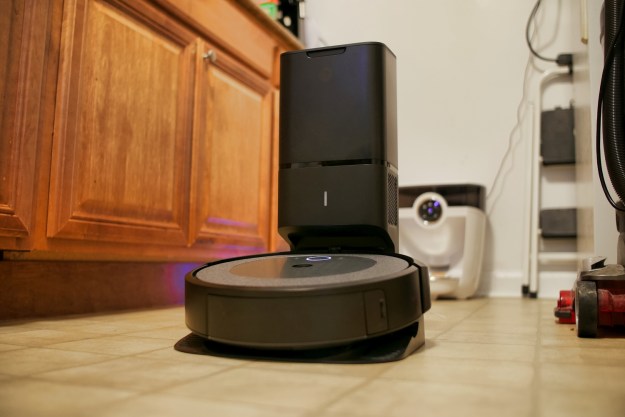
For several years now, there’s been buzz about wireless charging that doesn’t require you leaving devices on a special mat or nightstand, however. Energous and Ossia are two companies competing to bring wireless charging to your home, office, and the airport. They have different approaches: Energous hopes to power objects in a transmitter’s line of sight (and is rumored to be partnering with Apple), while Ossia uses lower power but can charge devices that are in a different room. Ossia recently showed off its idea for a ceiling tile that works as a transmitter for Cota, its wireless-charging platform, but neither company plans on having products available for purchase quite yet.
“Your slippers would tell you, ‘Easy on the chocolate.’”
“We would be able to speak to our doorknob and ask it for the weather,” he told Digital Trends. “Your slippers would tell you, ‘Easy on the chocolate.’” Companies making self-darkening glass have approached Ossia, looking for ways to make smart windows without wires or batteries.
Getting there
With a technology as new as this, Zeine says there will be four stages to adoption. First, your phone would be retrofitted with something like a charging case that could work with the transmitter. Next, device makers would start building specific devices that work with the transmitters; something that normally uses AA batteries could instead embed the wireless-charging technology. Devices begin to transform in the third phase, becoming smaller and lighter because they don’t need to house a bulky battery. Finally, designers start coming up with all new devices that wouldn’t be possible if they ran on batteries or had wires attached.
If there’s going to be billions of IoT devices in the next few decades, Zeine doesn’t see them running on batteries or being plugged into an outlet.
We’d all have to buy the transmitters for our homes at a price of several hundred dollars.
The last few stages require mass adoption of the technology. If your phone only works with a transmitter, and you can’t plug it in when you’re at the airport or get to your hotel, that’s not really appealing. Right now, Ossia’s transmitters need to be a certain size to work — big and flat like a ceiling tile or picture frame, or narrower and taller, like a tower. While Zeine thinks manufacturers should be able to absorb the cost of adding the tech to a new phone or electric toothbrush, we’d all have to buy the transmitters for our homes at a price of several hundred dollars. The cost would eventually drop to around $200, he predicts.
There’s something in the air
Recently, Ossia passed FCC safety tests that regulate Wi-Fi and Bluetooth. The company says Cota devices emit signals in the Wi-Fi 2.45GHz spectrum and bounce off walls, while the transmitter receives the signal and sends it back along the same path. Neither signal passes through people or pets, which limits RF radiation and absorption, according to the company. Keeping it safe means using lower wattage, meaning it will take devices a while to charge; plugging it in may be faster.
Yet Zeine thinks batteries have had their day. “When batteries were invented, Napoleon Bonaparte was alive,” he says. “Imagine that.”
Editors' Recommendations
- The Skylight Cal Max is a 27-inch smart calendar that might replace your smart display
- Pawport brings security (and smarts) to your existing pet door
- Kohler reveals luxurious smart home products that turn your bathroom into a spa
- Bring the Grinch to your front door with new Ring Quick Replies
- Alexa adds new features to help with your holiday shopping


